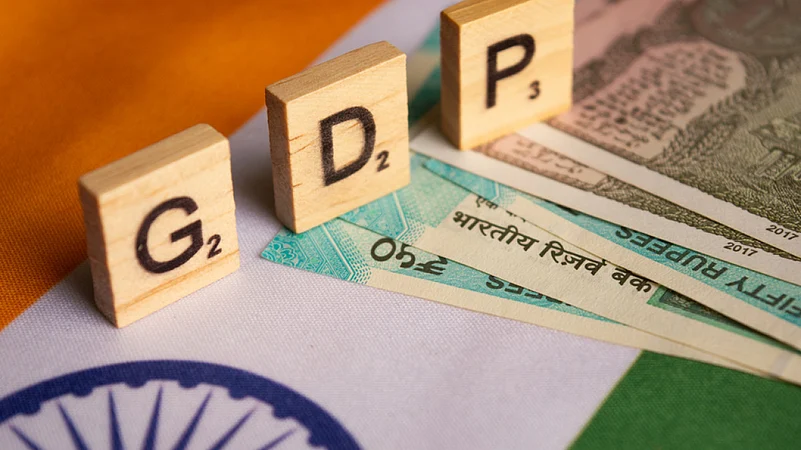India's GDP rose by 8.7% in FY22, compared with a contraction of 6.6% in FY21 on account of better performance by the manufacturing, mining, and construction sectors, official data showed on Tuesday
In the January-March period, the GDP, however, slowed 4.1 per cent from 5.4 per cent growth in the previous quarter as soaring prices slowed down consumer spending.
The 4.1 per cent expansion during the January-March period of 2021-22 is the lowest quarterly growth in the last fiscal. The growth was 20.1 per cent, 8.4 per cent, and 5.4 per cent, in the first, second and third quarters, respectively, as per the data released by the National Statistical Office (NSO).
Advertisement
The GDP had grown by 2.5 per cent in the January-March quarter of the previous year.
Gross value added (GVA) growth during the fiscal ending March 2022 was at 8.1 per cent as against a contraction of 4.8 per cent in the preceding year.
The GVA growth in the manufacturing sector accelerated to 9.9 per cent during the year as against a contraction of 0.6 per cent earlier. GVA growth in both mining and construction was 11.5 per cent. These two large segments of the economy had contracted in the COVID-hit 2020-21. However, agriculture sector growth decelerated to 3 per cent from 3.3 per cent in FY21.
Advertisement
Electricity, gas, water supply, and other utility services segment grew by 7.5 per cent during 2021-22. The segment had contracted by 3.6 per cent in the previous fiscal.
Agriculture, forestry and fishing grew 3 per cent compared to 3.3 per cent last year. Mining and quarrying posted an 11.5 per cent growth from a contraction of 8.6 per cent a year ago. Manufacturing grow 9.9 per cent year-on-year from a contraction of 0.6 per cent. Electricity, gas, water supply and other utility services grew 7.5 per cent year-on-year from a contraction of 3.6 per cent. Construction sector grew 11.5 per cent from a contraction 7.3 per cent last year. Trade, hotels, transport, communication, and services related to broadcasting grew 11.1 per cent from a contraction of 20.2 per cent a year ago.
“Global spillovers of supply shortages, crude oil shock, and higher input costs thwarted India’s growth momentum in 4Q FY22. The impact of these factors was widely witnessed in high-frequency mining, manufacturing, and construction indicators. So far in FY23, recovery in India’s domestic macros have been resilient to risks arising from global developments; however, supply-side challenges and inflation spikes, which could dampen consumption and investments in the economy, poses near term risk to India’s economic growth,” Vivek Rathi, Director - Research, Knight Frank India, said.
“FY22 Q4 GDP figures were expected to fall to below 4% but have managed to stay at 4.1%. The fall in GDP figures was expected especially due to the slowdown in the rural economy as higher input costs weigh on agricultural outputs. Supply chain disruptions continued to affect our economy. The FY22 GDP figure of 8.7% was in line with the estimates. The high growth figure is mainly due to the low base effect. Though inflation still poses a threat to our economy, RBI will continue to take steps and measures to control it. Unless the food and oil prices rise further, Indian companies have reported strong figures, which would help sustain the growth momentum in the future,” Raghvendra Nath, Managing Director – Ladderup Wealth Management Private Limited, said.
Advertisement
Inflation jumped to an eight-year high of 7.8 per cent in April and the Reserve Bank of India (RBI) was forced to raise repo rate by 40 basis points earlier this month in an unscheduled meeting.
The full year GDP data released today highlights the impact of the Russia-Ukraine war and rising crude prices has had on India’s growth. High crude prices have aided global inflation in commodity prices. Food prices have been on fire as the longer-than-anticipated Russia-Ukraine war disrupted global supply chains.
Finance minister Nirmala Sitharaman soon followed it up by announcing a host of measures to provide a safety net to India’s poor, reeling under the pressure of continuously rising prices. Primary among them was a cut in central excise on petrol and diesel.
Advertisement
The Centre announced the excise duty on petrol will be slashed by Rs 8 per litre, while the excise duty on diesel would be reduced by Rs 6 per litre. With this, petrol will be cheaper by Rs 9.5, whereas diesel will be cheaper by Rs 7.
The Covid-19 pandemic impacted India’s demand conditions due to large-scale job losses and salary cuts. This affected the consumption-driven growth story. Just as the country was gearing up to overcome the setback, the Russia-Ukraine war crippled global supply chains, pushing up prices of everything, from essentials to confectionary.
The manufacturing sector is also still reeling from the impact of the subsequent Covid waves. Industrial production growth remained subdued at 1.9 per cent in March compared to a year ago, mainly due to poor performance by the manufacturing sector which showed staggered impact of the third wave of the pandemic. The IIP growth was 1.5 per cent in January as well as February this year amid the third wave of Covid-19. It was just 1 per cent in November and December last year. Factory output grew by 4.2 per cent in October 2021.















 Just one email a week
Just one email a week